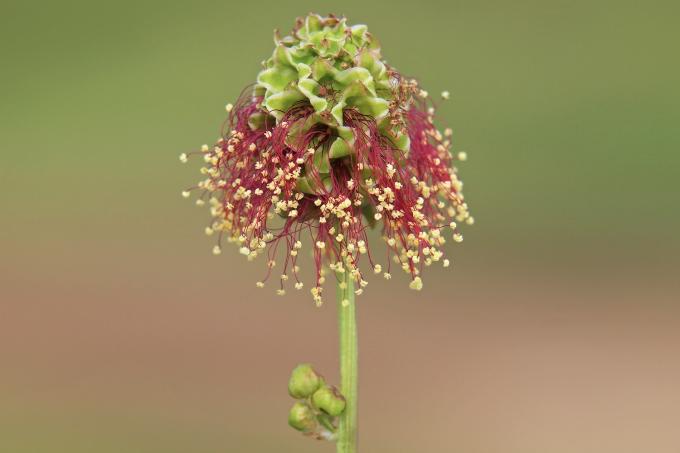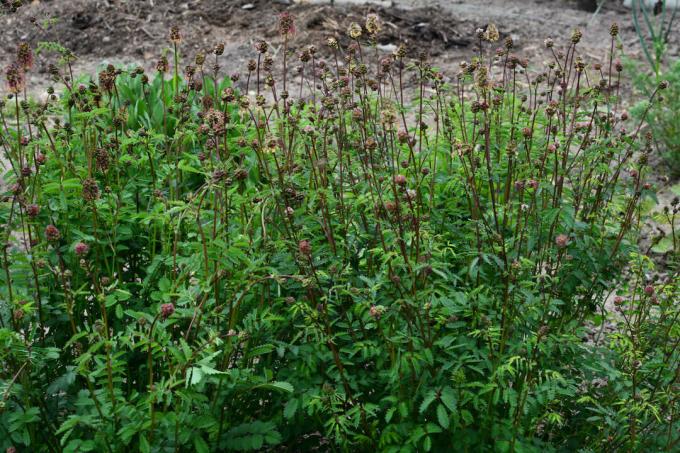The burnet, also known as the small burnet, is known to only a few as a kitchen herb. We reveal how to grow, harvest and use the burnet yourself.

More and more people rely on home-grown herbs from their own garden. But in addition to the extremely popular classics such as chives (Allium schoenoprasum) and parsley (Petroselium crispum ssp. crispum) there are also less well-known but no less tasty garden herbs such as burnet burnet (Sanguisorba minor). Read with us where the herb comes from, how to cultivate and use it properly.
"Contents"
- Burnet: flower, characteristics and origin
- Plant burnet
- Care of the lesser burnet
- Is the burnet hardy?
- propagation
- Harvesting burnets: timing and procedure
- Use of the burnet
- Dry and preserve the burnet
Burnet: flower, characteristics and origin
The burnet is one of the lesser-known garden herbs, but it is an indispensable ingredient in classic dishes such as the Frankfurt green sauce. It belongs to the genus of burnet (
Sanguisorba), which is part of the rose family (Rosaceae). Depending on the region, it is also known as the small burnet, burnet burnet or garden burnet. The perennial, herbaceous plant originally comes from southern and central Europe, but is widespread as far as Scandinavia, Afghanistan and North Africa. The burnet can grow both in the lowlands and in medium mountainous areas, preferring lean soils. It is therefore considered an indicator plant for a nutrient-poor soil.Burnets can grow between 20 and 100 cm high, with the shoots growing out of the rhizome like a rosette. The pinnate leaves carry 11 to 31 imparately arranged leaflets along the stem. The burnet grows perennial and often remains green during the winter, but it can also die above ground in autumn and sprout again from the rhizomes in spring. Between May and August the burnet forms a spherical inflorescence of up to 3 cm in diameter. The flower structure is something special due to the division into three parts: female, red flowers grow at the top, in the hermaphroditic flowers in the middle and male flowers in the lower part with a conspicuously protruding anther.

Due to a temporally different maturity from top to bottom, self-pollination is avoided, which means that the plant specifically prevents inbreeding. Because of its good flowering values, the burnet is also a particularly bee-friendly plant and is visited not only by the wind but also by bees. Naturally, the burnet can spread via stolons in the ground, so-called rhizomes, or via seeds. The seeds are inside a small nut, which uses the surrounding flower cup as a flight or flotation device. Burnet nuts are hibernating, which means they can remain on the plant throughout the winter and often don't spread until the following year.
The burnet, like the closely related Greater burnet (Sanguisorbar officinalis) – about medicinally interesting ingredients. For this reason, both plants are of interest in medieval medicine and also in today's domestic medicine and homeopathy.
Risk of confusion burnet burnet: "Pimpinelle" is also the name of some plants of the burnella genus (pimpinella) from the umbelliferae family (Apiaceae), which includes, for example, the anise (Pimpinella anisum) belongs. Burnella are mainly distributed in Eurasia and Africa, with only 16 species found in Europe.
Plant burnet
Planting burnets usually works without any problems, provided the site requirements are right. A sunny location on dry, calcareous and loose soil is best, with nutrient-poor loamy soil being an advantage because of the high water storage capacity. Naturally, the burnet grows on patchy lean or semi-arid grassland and loves warmth. Due to the low nutrient requirement, a nutrient-poor soil is suitable as a substrate, the water storage capacity of which can be improved by adding pumice sand or zeolite. Too nutrient-rich soil should not be used, as the burnet reacts sensitively to an oversupply, which manifests itself in soft shoots, pale leaves and reduced growth. A good basis for the Pimpinelle is, for example, ours Plantura organic herb and seed soile, which avoids over-fertilization thanks to its low nutrient content, which is ideal for herbs and thus promotes healthy plant growth. In addition, our soil is made entirely without peat, which reduces the release of CO2 avoided by the peat extraction and thus protects the environment.
The ideal sowing time for the burnet is from the beginning of April to mid-June. The burnet seeds can be sown directly into the bed about 5 cm apart and pressed down lightly. Because the burnet a light germinator is, the seeds should not be covered with soil. With a germination temperature of 15 °C and regular watering to keep the soil constantly moist, the seeds will germinate after about two to three weeks. After germination, the stock should be thinned out so that there is a planting distance of about 20 cm.
The burnet is not well suited as a pot plant, as it requires a relatively large pot of more than 40 cm depth due to its very extensive and deep root system.
Care of the lesser burnet
The most important care measure for the small burnet is regular watering. During the warm summer months it is important to keep the substrate constantly moist, but at the same time not to water too much to avoid water saturation and the root rot that often accompanies it avoid. Pumice sand or zeolite added to the substrate ensure a good, permanent water supply. Since the burnet is a weakly nutrient-consuming plant, fertilization is generally not necessary. Weeds should be chopped as needed so that there is no competition for light or water between the weeds and the burnet. This is an important measure, especially for young plants. In addition, inflorescences should be removed regularly during flowering to encourage the growth of young burnet leaves.
Tip: Anyone who cultivates the burnet in a pot or raised bed should bring in a small amount of organic fertilizer every year to ensure a long-term, needs-based supply of nutrients. Our Plantura organic universal fertilizer for example, thanks to its granular form, it can provide nitrogen and other essential nutrients over a long period of time. For herbs, a small dosage of 40 to 60 g per square meter is sufficient for a complete vegetation period.

Is the burnet hardy?
Since the burnet is native to our latitudes, it is hardy without hesitation and overwintering measures are not necessary. As a rule, the burnet survives the winter as a green semi-rosette, from which it sprout again in spring. In the so-called semi-rosettes - just like in rosette plants - some leaves grow in a rosette-like manner at the base of the stem, but they also have leaves on the stem. The leaves die off very slowly, which is why the plant often stays green during the winter. However, if you want to use the burnet as a kitchen herb, you should sow it every two years or through it propagate young offshoots vegetatively, as older plants lose their aroma and become increasingly stunted grow.
propagation
The propagation of the burnet is easy because it is partly done by the formed rhizomes themselves. The rhizomes can be dug up, carefully divided and then replanted individually. Alternatively, the burnet can be re-sown through the seeds in the nuts. At the end of the year, the nuts can be removed from the inflorescence, stored in a dry and dark place and sown next year.
Harvesting burnets: timing and procedure
The harvest of the burnet is possible between May and September. In addition, young, pinnate leaves can be harvested continuously. It's best to use them immediately, as they don't lose their flavor that way. A sharp knife is suitable for cutting off the leaves, as scissors can bruise them.

Use of the burnet
Both leaves and flowers of the burnet are edible without hesitation, their taste is spicy-nutty and reminiscent of cucumbers. They can be used in smoothies and other drinks, in salads, in marinades, sauces or as a seasoning for poultry and fish. However, they should not be boiled, as the aroma is destroyed at too high temperatures. Probably the best-known use of the burnet is as a herb for the Frankfurt green sauce.
As a meadow plant, it often ends up in silage and is therefore processed into animal feed, and it does not pose a threat to domestic animals either.
The burnet is closely related to the burnet (Sanguisorbar officinalis) is related, but it can grow up to 120 cm high and develops more showy, deep red inflorescences. In the Middle Ages, the two types were regarded as one and used in medicine, among other things, because of the tannins and bitter substances they contained. This was used to treat stomach and menstrual problems, inflammatory skin diseases and sunburn. However, only a few recommendations for use can be found in historical sources. Apparently, both a tea made from the leaves of the burnet and a decoction made from its roots can be used. Burning pepper tea made from 4 - 5 teaspoons of fresh herb and 200 ml of 90 °C warm water, which is allowed to steep for 6 to 10 minutes, may stimulate digestion.
Whether the burnet really develops the effect attributed to it has so far only been little scientifically investigated. However, it can be proven that many enzymes are stimulated by the intake of the polyphenols contained. An effect on cancer cells by the contained quercetin could also be proven. So far, however, only in an in-vitro experiment, i.e. in a Petri dish and not on the living body of a patient.

Dry and preserve the burnet
The leaves of the burnet can be dried to preserve them. As a result, however, they lose a lot of their taste and are no longer suitable as a kitchen herb. They are then used almost exclusively as tea leaves. It is better to freeze the burnets, as this preserves the taste and the leaves can be used for about a year. The finely chopped leaves can simply be placed in a suitable jar or bag and frozen.
Are you considering starting a new herb garden? Here you can find out which herbs go well together.

